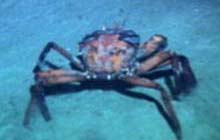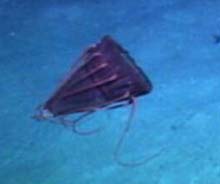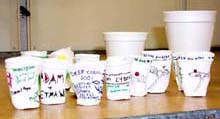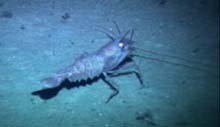
The DSV (deep submergence vehicle) Alvin and her crew being hoisted aloft by the R/V Atlantis' A-frame in preparation for a descent into Hydrographer Canyon. Click image for larger view.
Hydrographer Canyon
September 14, 2001
Diana Payne
The Maritime Aquarium at Norwalk/
Connecticut Sea Grant
Karl Stanford, Teacher
Lincoln Academy, Newcastle, Maine
Little drops of water, little grains of sand,
Make the mighty ocean and the pleasant land.
So the little minutes, humble though they be,
Make the mighty ages of eternity.
-- Julia A. Fletcher Carrey, Little Things
"It wouldn't be exploration if everything happened as planned." -- Dr. Barbara Moore, Director, National Undersea Research Program
Every day for the past three days, we awoke to the realization that the dive was cancelled yet again. In fact, cancellation was becoming the routine. Today, that ended. We had slept well, without the violent tossing, turning, and rolling that had interrupted our sleep for so many nights. This morning the seas were calm, or at least close enough for an Alvin launch. Dr. Ivar Babb and Dr. Les Watling, along with Alvin pilot Bob Brown, climbed the stairs along the A-frame and disappeared into the sail of the DSV Alvin. The entire science party was relieved to see this dive -- our second and last on Leg 1 of Deep East -- come to pass.

The red crab Chayceon quinquedens is one of the species responsible for the many burrows seen at Hydrographer Canyon. Click image for larger view.
Today's dive was into Hydrographer Canyon. The research vessel (R/V) Atlantis' SeaBeam multibeam sonar system had surveyed and mapped the canyon as we slept. By breakfast, the dive location had been selected based on the SeaBeam map. The submersible dove to a depth of 1,393 m, then ascended a section of canyon wall. During the dive, Alvin's digital video cameras recorded the canyon's biodiversity. The benthic substrate in this section of Hydrographer Canyon is different from that found in Oceanographer Canyon a few days ago. This section of the canyon is steeply sloped, with a muddy bottom. The bottom is also heavily bioturbated (disturbed due to animal activity), primarily by red crabs. Four glacial erratics -- rocks suspended in glacial ice and deposited when the glacier melts -- were also found in this section of the canyon.
Dr. Barbara Hecker had predicted that we would not find the same community in Hydrographer Canyon as was found in Oceanographer Canyon. Corals, she suggested, would not be well represented here because they need a rocky substrate. As the science team reviewed video footage, a rich community was revealed. Numerous individuals representing many different species were observed. Dr. Hecker's prediction was correct, however; no corals were found
Alvin's final dive of this leg of the Deep East Expedition also yielded some interesting conversation pieces for the crew. As is the tradition on Alvin missions, most of the science party spent a few minutes last night decorating styrofoam drinking cups with grafitti, artwork, dates, and the signatures of fellow "Deep Easters." The cups were put into a mesh bag in Alvin's hangar, and technicians placed the bag inside Alvin before the dive. Styrofoam cups are good insulators for hot drinks because of the trapped air pockets in them. At normal atmospheric pressure (14.7 lbs per sq in (psi)), the size of the air pockets remains constant. At 1,393 m, however, the pressure is crushing, about 2,000 psi. At that depth, the air pockets are literally squeezed out of existence. The result is a shrunken cup, tiny to hold, yet holding huge memories.
A crisp American flag hangs in the R/V Atlantis' mess deck tonight, along with the words "America . . . land of the free and home of the brave" as we steam back toward Woods Hole, MA. Tomorrow, the science party will be replaced by the researchers for Leg 2 of Deep East, which will explore the Hudson Canyon offshore of New York and New Jersey. As we near home, we wish the new science party calm seas and a safe journey. We return to a world that has changed greatly since we last walked on our homeland.

Dr. Barbara Heker, deep-sea biologist.
Interview with Dr. Barbara Hecker
Marine Ecological Consultant and Lecturer
Boston University Marine Program
Marine Biological Laboratory
Woods Hole Oceanographic Institution
Ocean Explorer Team: How did you get involved in the Deep East Expedition?
Dr. Hecker: My background is relatively strong in the area of deep-water corals, which is the main focus of study during Leg 1 of this expedition. Dr. Les Watling and Dr. Peter Auster invited me to help with the project on deep-water octocorals and benthic communities. I have a fair amount of experience diving in submersibles in this geographical area, mostly in the Alvin, so I have a keen interest in what we find. My past studies have allowed me to experience area surveys, which help in understanding the landscape of the study site.
Ocean Exploration Team: Describe your passion for corals.
Dr. Hecker: Good question! I tend to get passionate about whatever I am studying, and corals are just part of the larger picture. When doing a study off the coast of New Jersey, I got excited about the clams we found. If something is unique and little is known about it, that is what intrigues me to find out as much as I can. Very little is known about deep-sea octocorals. My first dive in the Alvin was in Heezen Canyon in 1977. It's hard to describe the thrill of seeing animals and plants that no other person has ever seen before and that have never been identified.
Ocean Explorer Team: How long have you been an ocean explorer, and what sparked your interest in science?
Dr. Hecker: I began exploring the deep sea about 25 yrs ago, in 1976. What sparked my interest in science was a passion for the ocean from childhood on. My family would find me with my head in the water at the beach all the time. I always found my way into the water! I'm fascinated by the ocean and animals. If I had not become a marine scientist, I probably would have been a veterinarian. To me, biological communities are a puzzle. Each living thing represents a small piece of the entire puzzle, and it's fascinating to investigate how these pieces fit into the whole living system, i.e., what lives there, and why? My intellectual curiosity is what drives me. The deep sea has not been explored much. We need to further our investigation of this environment to understand its importance on Earth.
Ocean Explorer Team: What other scientific expeditions have you participated in?
Dr. Hecker: I have been involved with more than 30 expeditions in my career. My first cruise was in 1977 with the Alvin under Dr. Fred Grassle, who happens to be the chief scientist for Leg 2 of the Deep East Expedition. With my experience from my first ocean exploration, I participated in a second study in a submarine canyon. One expedition I remember, in particular, was an expedition to the Florida Escarpment in March 1984. This was the first discovery of a cold-water chemosynthetic seep community nowhere near any hydrothermal vents. That was an exciting expedition! I have done other studies of deep cold-water seep communities. Two of them took place in Monterey Canyon off the coast of Californ. One of those studies used the Alvin submersible, and the other one used the Navy submersible Sea Cliff, which is capable of diving even deeper than Alvin.

This unusual deep-sea medusa (jellyfish) was observed in Hydrographer Canyon. Click image for larger view.
Ocean Explorer Team: What was it like for you when they brought up the biological samples from the first Deep East Alvin dive? What species were found?
Dr. Hecker: The anticipation of what's going to come up from a dive always makes any discovery exciting. After Monday's dive, the samples were removed from the bio-box (the biological collection container on the Alvin, also known as "the coffin"). The scientists sorted them into special containers on the boat deck for the laboratory technicians to try and identify. We use many techniques to identify species, from visual identification to utilizing field guides and taxonomic keys. I also found it thrilling to review the film taken during Alvin's first dive. The video showed the complexity of the physical wall of Oceanographer Canyon and the organisms inhabiting it. It's the whole perspective that I appreciate most.
The samples that Alvin brought up on the first dive were identified within an hour. Through our investigations, we came to the conclusion that we had some interesting species of fauna. The Paramuricea grandis, a pretty yellow coral, and the Anthothela grandiflora, which is light pink, were present. A large, tree-like coral skeleton was Paragorgia arborea. By the size of this coral, it was determined to be more than 100 yrs old. We also found brittle stars (ophiuroids) wrapped in Paramuricea colonies. It is not uncommon to find brittle stars in the center of a coral colony. One octocoral was very unique, and looked like a three-dimensional bottle brush. Our best identification of that animal would be a Thouarella. Another colony required using the microscope to determine that it was actually a coral skeleton overgrown by anemones. A thorough investigation of our finds, however, will include genetic testing. While studying the polyps of another coral sample under the microscope, we saw eggs being released. Then we took a closer look, only to realize that the coral had released not eggs, but sperm sacs. The surprises in science are what makes discovery so exciting! And here you are, the reader, getting it hot off the press!
Interview by Caren A.D. Menard of the Ocean Explorer Team.
Sign up for the Ocean Explorer E-mail Update List.


































